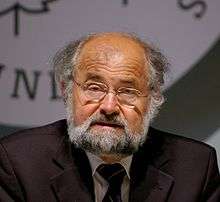Erwin Neher
| Erwin Neher | |
|---|---|
 Erwin Neher (2007) | |
| Born |
20 March 1944 Landsberg am Lech, Bavaria, Germany |
| Nationality | German |
| Fields | biophysics[1][2][3] |
| Institutions | |
| Alma mater | |
| Academic advisors | Charles F. Stevens |
| Known for | patch clamp |
| Notable awards |
|
|
Website www | |
Erwin Neher (born 20 March 1944) is a German biophysicist, specializing in the field of cell physiology. For significant contribution in the field, in 1991 he was awarded, along with Bert Sakmann, the Nobel Prize in Physiology or Medicine for "their discoveries concerning the function of single ion channels in cells".[5][6][7]
Early life and education
Neher was born in Landsberg am Lech, Upper Bavaria, the son of Elisabeth (née Pfeiffer), a teacher, and Franz Xaver Neher, an executive at a dairy company.[8] He studied physics at the Technical University of Munich from 1963 to 1966.
In 1966, he was awarded a Fulbright Scholarship to study in the US. He spent a year at the University of Wisconsin–Madison, and earned a master's degree in biophysics. While at the Charles Stevens Laboratory at Yale University for post-doctoral work he met fellow scientist Eva-Maria Neher, whom he married in 1978 and subsequently the couple had five children – Richard, Benjamin, Carola, Sigmund, and Margret.[9]
In 2003 Neher was one of 22 Nobel Laureates who signed the Humanist Manifesto.[10]
Career
In 1986, he was awarded the Louisa Gross Horwitz Prize from Columbia University together with Bert Sakmann. In 1987, he received the Gottfried Wilhelm Leibniz Prize of the Deutsche Forschungsgemeinschaft, which is the highest honour awarded in German research. Along with Bert Sakmann, he was awarded the Nobel Prize in Physiology or Medicine in 1991 for "their discoveries concerning the function of single ion channels in cells".[11] Neher and Sakmann were the first to record the currents of single ion channels on a live cell (they were first recorded using the lipid bilayer method) through their development of the patch-clamp technique,[12][13][14][15] a project Neher began as a postdoctoral research associate in the laboratory of Charles F. Stevens at Yale.
He is now a director at the Max Planck Institute for Biophysical Chemistry in Göttingen and heads its Department for Membrane Biophysics. He is also a Professor at the University of Göttingen and a co-chair of the Bernstein Center for Computational Neuroscience Göttingen.
Honors and awards
Neher was awarded an Honorary degree from the University of Pavia in 2000. He was elected a Foreign Member of the Royal Society (ForMemRS) in 1994.[4]
References
- ↑ Elektronische Messtechnik in der Physiologie. Berlin, New York, Springer-Verlag, 1974.
- ↑ Single-channel recording / edited by Bert Sakmann and Erwin Neher. New York : Plenum Press, c1983. ISBN 0-306-41419-8
- ↑ Single-channel recording / edited by Bert Sakmann and Erwin Neher. 2nd ed. New York : Plenum Press, c1995. ISBN 0-306-44870-X
- 1 2 "Professor Erwin Neher ForMemRS". London: Royal Society. Archived from the original on 2015-10-11.
- ↑ Nobel autobiography of Neher
- ↑ Neher Scientific genealogy
- ↑ Freeview video 'An Interview with Erwin Neher' by the Vega Science Trust
- ↑ http://www.nobelprize.org/nobel_prizes/medicine/laureates/1991/neher-bio.html
- ↑ Schoenfeld 2006, p. 264.
- ↑ "Notable Signers". Humanism and Its Aspirations. American Humanist Association. Retrieved October 4, 2012.
- ↑ "The Nobel Prize in Physiology or Medicine 1991". Nobelprize.org. Retrieved 16 May 2011.
- ↑ Neher E, Sakmann B (March 1992). "The patch clamp technique". Scientific American. 266 (3): 44–51. doi:10.1038/scientificamerican0392-44. PMID 1374932.
- ↑ Neher E (1992). "Correction for liquid junction potentials in patch clamp experiments". Methods in Enzymology. Methods in Enzymology. 207: 123–31. doi:10.1016/0076-6879(92)07008-C. ISBN 978-0-12-182108-1. PMID 1528115.
- ↑ Neher E (September 1988). "The use of the patch clamp technique to study second messenger-mediated cellular events". Neuroscience. 26 (3): 727–34. doi:10.1016/0306-4522(88)90094-2. PMID 2462183.
- ↑ Neher E, Sakmann B, Steinbach JH (July 1978). "The extracellular patch clamp: a method for resolving currents through individual open channels in biological membranes". Pflügers Archiv. 375 (2): 219–28. doi:10.1007/BF00584247. PMID 567789.
Bibliography
- Schoenfeld, Robert L (January 2006). Exploring the Nervous System: With Electronic Tools, an Institutional Base, a Network of Scientists. Universal-Publishers. ISBN 978-1-58112-461-3.
